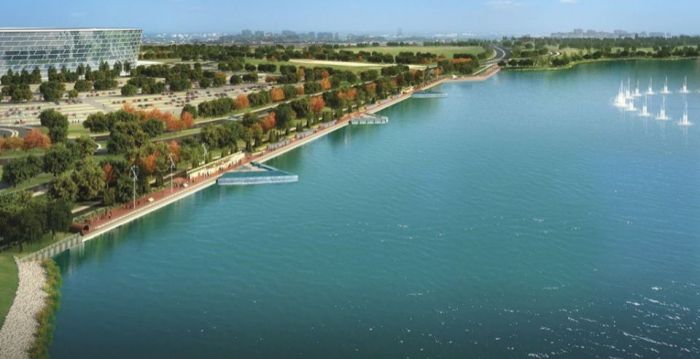Azerbaijan moves ahead with pilot project for floating solar power system in Lake Boyukshor
Azerbaijan, a country whose exports are nearly 90% hydrocarbons, has been experimenting with innovative green energy plans.
Last week, the country's energy ministry revealed that an agreement has been reached with the Asian Development Bank for the installation of a floating photovoltaic power generation plant on Lake Boyukshor, just next to the capital city of Baku.
The project had first been mentioned by the ministry in July 2018 and has been described as an agreement for “Technical Support and Knowledge Sharing for the Development of a Floating Solar Panel System."
Now these plans seem to be getting more concrete. According to the ministry's website, a photovoltaic solar plant with a 100KW generation capacity will start development and be operational by 2020. Azerbaijani news outlets have, however, set the summer of 2021 as the due date for the project.
The ministry's press release goes on to suggest the project will possibly be connected to the Koroghlu substation.
Very few other details are known about the Azerbaijani project, and admittedly, 100KW of capacity is just a drop in the ocean for the nation, but it serves as an anecdotal example of the government's wider push for renewable energy development in the country.
More significant than the floating iteration are the 23 renewable energy projects that the State Agency for Alternative and Renewable Energy Sources (SAARES) plans to implement in the run up to 2023, with an investment of over USD7.6 million.
Wind turbines, micro-hydro projects, solar farms, and biofuel power plants account for most of the investment that is expected to translate into a generation capacity of 4.2 GW of power.
Most of the focus will be on wind power, which is expected to amount to as much as 3.5GW.
To be sure, the oil and gas-rich nation holds incredible potential for renewable energy development, particularly when it comes to solar power. Azerbaijan benefits from between 2,400-3,200 hours of sun exposure throughout the 300 sunny days it has per year.
According to local news agency AzerNews, the country holds the potential to produce 5GW of power from solar energy, 4.5GW from wind power, 1.5GW from biomass, 800MW from geothermal energy, and 350MW from small hydro projects. These projects should save up to 2.986 million cubic meters in natural gas consumption per year.
According to official figures, in 2018 Azerbaijan produced 10% of its energy from renewable energy sources, a figure that should rise to 12% by 2020 and 20% by 2030, if all the development plans come to fruition.
The country is also tapping into the renewable energy markets through another route. Since 2012, the “Azguntex" facility, built by the SAARES, has been producing solar panels for both the domestic and the international market.
As the technology evolved, the plant needed to modernize its 250-watt panels and it is now building the capacity to produce 300-330-watt panels on its two production lines, which will collectively produce 100,000 panels per year.
According to statements made by the Azguntex's chief technologist Nizami Asgarov in mid-January, the plant will soon start exporting panels to Germany, and negotiations are underway to start supplying the Turkish, Iranian, Emirati, and Georgian markets too.
The article was published by The Business Year
KarabakhToday












